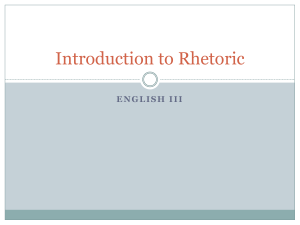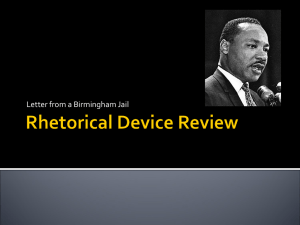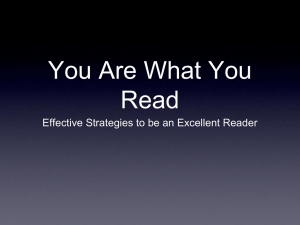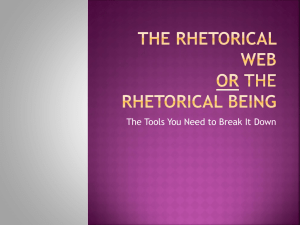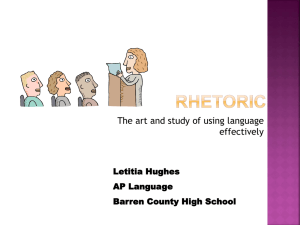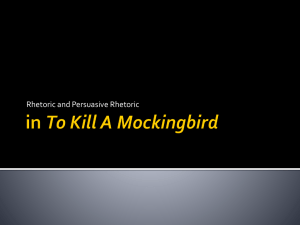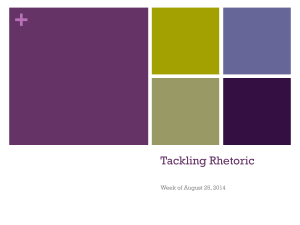A Brief Guide to Rhetorical Analysis
advertisement
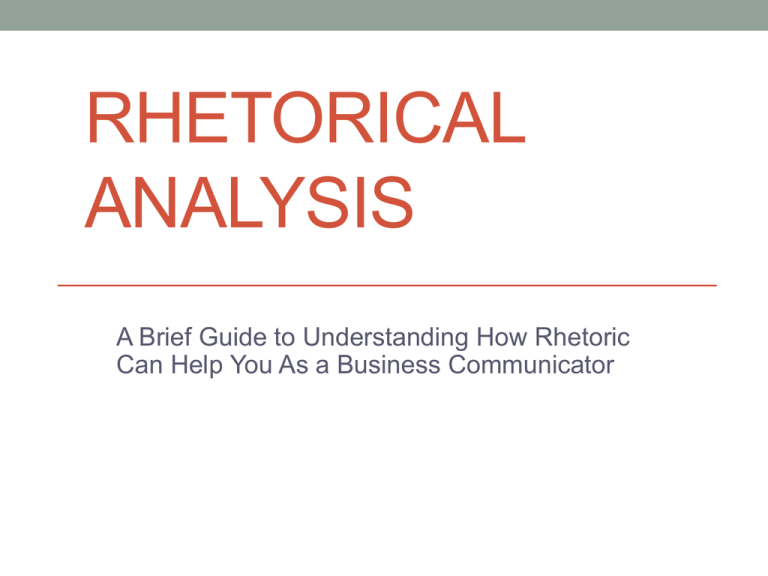
RHETORICAL ANALYSIS A Brief Guide to Understanding How Rhetoric Can Help You As a Business Communicator What Is Rhetoric? • The term rhetoric refers to the use of language to present ideas, information, & argumentation • Rhetoric is often associated with persuasive speech, oration, or a particular style of speaking or writing • Rhetoric can also be defined as a form of verbal or written communication or discourse • According to Aristotle, rhetoric is "the ability, in each particular case, to see the available means of persuasion" (1.2.1) Rhetorical Triangle Consider the relationship between communicator, message, and audience. How can understanding this relationship help you as a professional communicator? Primary Rhetorical Forms • Logos is an appeal based on logic or reason. Documents distributed by companies or corporations are often logosdriven, as are scholarly or academic books & articles. • Ethos is an appeal based on the character or crediblity of the speaker. An ethos-driven document relies on the reputation of the author. • Pathos appeals to emotion. Advertisements tend to be pathos-driven. See handout on course website under Unit One titled “Understanding Ethos, Logos, Pathos” for examples. Also review the video “Rhetoric in Advertising.” Rhetorical Sensitivity • Rhetorical sensitivity occurs when writers “determine the most effective ways to communicate with readers” (Ede p. 40). • As business communicators, you must develop rhetorical sensitivity. You achieve this by adopting an audiencecentered approach. (Review pgs. 10-16 in your course textbook for more information.) Other Rhetorical Appeals • Rhetorical appeals can also be achieved through: • Visual Information Structure—this includes how the text looks and is presented. Examples: titles, headings, navigation, etc. • Color—this includes the color of the text, background, and graphics. Color contrast is also important. • Graphic Images—this includes other information in the document aside from the text. Examples: icons, buttons, and photos. Analyzing Rhetoric • When you rhetorically analyze a text you study the ways and modes through which a communicator uses language and other rhetorical devices to convey ideas & information • Consider the following: • • • • • • • Audience Word choice Tone Organization Narrative Structure Appeals (ethos, logos, pathos) Genre Example Image of gecko is well-known and reinforces ad’s ethos or credibility Visual design is simple, professional, and visually pleasing. Tone of ad is humorous, yet credible. Word choices like “24-hour service” and “low downpayment” appeal to viewers’ desire to save money. Logos or logical appeal—i.e. you will save money! Ad uses complimentary, yet contrasting, colors. Green & blue are “trustworthy” colors, which boost the ad’s ethos. (Perhaps more so than bright pink or neon yellow, for example.) Ad is genreappropriate—i.e. it meets audiences’ expectations for how a car ad should look and what content it should contain. Questions • What are some examples of texts you have read in this class or others that use one or more of the rhetorical appeals we just reviewed? • Why is rhetorical analysis important for professional communicators? • How might studying rhetoric help you become a critical reader and writer? • Which aspects of rhetorical analysis do you have questions about? Post them to our discussion forum for further conversation! Works Cited • Aristotle. Rhetoric. • Ede, Lisa. (2011). The Academic Writer. • Bovee, Courtland and John Thill. Business Communication Today. (2012).


